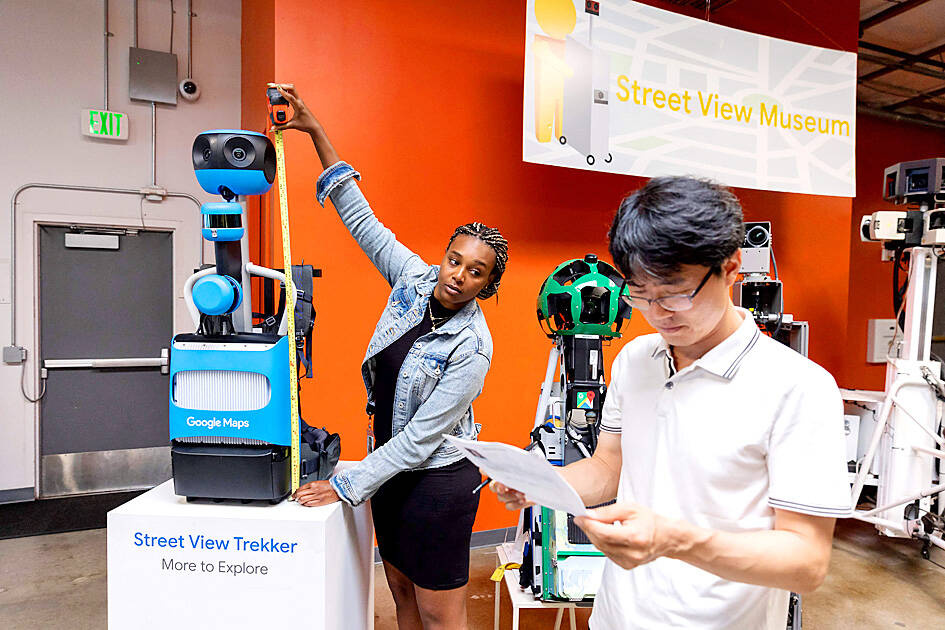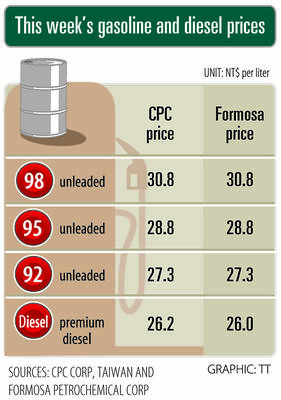Fifteen years after its launch, a Google Maps feature that lets people explore faraway places as though standing right there is providing a glimpse of the “metaverse” being heralded as the future of the Internet.
There was not yet talk of online life moving to virtual worlds when a “far-fetched” musing by Google cofounder Larry Page prompted Street View, which lets users of the company’s free navigation service see imagery of map locations from the perspective of being there.
Now the metaverse is a tech-world buzz, with companies including Facebook parent Meta Platforms Inc investing in creating online realms where people represented by video-game-like characters work, play, shop and more.

Photo: AFP
“Larry Page took a video camera and stuck it out the window of his car,” Google senior technical program manager Steven Silverman said, while showing the garage where the company builds cameras for cars, bikes, backpacks and even snowmobiles dispatched to capture 360° images worldwide.
“He was talking to some of his colleagues at the time, saying: ‘I bet we can do something with this.’ That was the start of Street View,” Silverman said.
Street View lets people click on locations in Google Maps to see what it might look like were they at that spot, and even look around.
Now, the Internet behemoth is introducing an “immersive view” that fuses Street View images with artificial intelligence to create “a rich, digital model of the world,” Google Maps experiences vice president Miriam Daniel wrote online.
“You’ll be able to experience what a neighborhood, landmark, restaurant or popular venue is like — and even feel like you’re right there before you ever set foot inside,” Daniel said.
“With a quick search, you can virtually soar over Westminster to see the neighborhood and stunning architecture of places, like Big Ben, up close,” she said.
Google is to start rolling out immersive view later this year, starting in Los Angeles, London, New York, San Francisco and Tokyo.
Street View imagery has been gathered in more than 100 countries and territories, ranging from places such as Mount Fuji and Grand Canyon National Park to the Great Barrier Reef.
“If you want to see what it’s like to go down a ski slope, you can see where that snowmobile has gone,” Silverman said, nodding toward a maroon snowmobile in the garage in the Silicon Valley city of Mountain View, California.
“That trike was really funny because it went around Stonehenge; and we put it on a barge and went down the Amazon River,” he said of another vehicle.
He pointed to a backpack camera system taken for a zip-line ride in the Amazon, to provide a bird’s-eye perspective.
Years spent capturing the real world in 360° imagery bodes well for Google when it comes to a future in which Internet life shifts to immersive digital worlds, said Creative Strategies tech analyst Carolina Milanesi.
“It absolutely plays into the metaverse,” Milanesi said. “The idea of a digital twin of the world is certainly one aspect of it that Google will solve.”
Silverman reasoned that, in a sense, Street View has been giving users a virtual experience for more than a decade, and the imagery naturally lends itself to depicting the real world in virtual settings.
“Ideally, that metaverse, that world that we move into, we’re going to be there,” Silverman said.
Scores of tech firms have been rushing to invest in building the metaverse, a loose term covering the growing ecosystem of interactive online worlds, games and 3D meeting places that are already attracting millions of users.
Facebook renamed its parent company to Meta last year to emphasize its virtual reality vision, and opened Horizon World virtual reality platform to the North American public.
Earlier this year, Japanese giant Sony Corp and Lego’s Danish parent firm announced a US$2 billion investment in US gaming powerhouse Epic Games for its work toward joining the metaverse vision for the Internet’s future.
What started as a “far-fetched idea” by Page is “critical to our mapping efforts — letting you see the most up-to-date information about the world, while laying the foundation for a more immersive, intuitive map,” Google Maps product director Ethan Russell wrote in a blog post.

SETBACK: Apple’s India iPhone push has been disrupted after Foxconn recalled hundreds of Chinese engineers, amid Beijing’s attempts to curb tech transfers Apple Inc assembly partner Hon Hai Precision Industry Co (鴻海精密), also known internationally as Foxconn Technology Group (富士康科技集團), has recalled about 300 Chinese engineers from a factory in India, the latest setback for the iPhone maker’s push to rapidly expand in the country. The extraction of Chinese workers from the factory of Yuzhan Technology (India) Private Ltd, a Hon Hai component unit, in southern Tamil Nadu state, is the second such move in a few months. The company has started flying in Taiwanese engineers to replace staff leaving, people familiar with the matter said, asking not to be named, as the

The prices of gasoline and diesel at domestic fuel stations are to rise NT$0.1 and NT$0.4 per liter this week respectively, after international crude oil prices rose last week, CPC Corp, Taiwan (台灣中油) and Formosa Petrochemical Corp (台塑石化) announced yesterday. Effective today, gasoline prices at CPC and Formosa stations are to rise to NT$27.3, NT$28.8 and NT$30.8 per liter for 92, 95 and 98-octane unleaded gasoline respectively, the companies said in separate statements. The price of premium diesel is to rise to NT$26.2 per liter at CPC stations and NT$26 at Formosa pumps, they said. The announcements came after international crude oil prices

A German company is putting used electric vehicle batteries to new use by stacking them into fridge-size units that homes and businesses can use to store their excess solar and wind energy. This week, the company Voltfang — which means “catching volts” — opened its first industrial site in Aachen, Germany, near the Belgian and Dutch borders. With about 100 staff, Voltfang says it is the biggest facility of its kind in Europe in the budding sector of refurbishing lithium-ion batteries. Its CEO David Oudsandji hopes it would help Europe’s biggest economy ween itself off fossil fuels and increasingly rely on climate-friendly renewables. While

SinoPac Financial Holdings Co (永豐金控) is weighing whether to add a life insurance business to its portfolio, but would tread cautiously after completing three acquisitions in quick succession, president Stanley Chu (朱士廷) said yesterday. “We are carefully considering whether life insurance should play a role in SinoPac’s business map,” Chu told reporters ahead of an earnings conference. “Our priority is to ensure the success of the deals we have already made, even though we are tracking some possible targets.” Local media have reported that Mercuries Life Insurance Co (三商美邦人壽), which is seeking buyers amid financial strains, has invited three financial